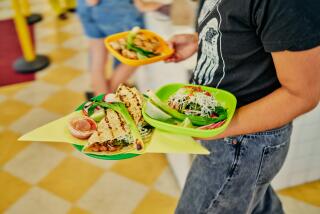Cartagena Moves to the Rhythms of Radio Daze
- Share via
CARTAGENA, Colombia — The first thing people here do in the morning is switch on the radio and turn it up loud.
The ensuing racket has become as characteristic of this South American city as its marvelous beach and the virtually unaltered European tone of its captivating Old City, which dates to the 16th Century.
Sited on the continent’s northwestern shoulder, Cartagena was one of the ports from which Spain’s looted gold was shipped to Europe. Given an incentive like that, the better class of buccaneer--Sir Francis Drake among them--was constantly capturing the city.
Tiring of such disruptions, the conquistadores built a series of fortifications to fend off the sea-borne brigands.
It worked. In 1740, 500 soldiers, plus an odd lot of 2,500 Indians and slaves, repulsed a British force eight times as large.
Amiable Looting
Today the only pirates in evidence are the vendors, and what innocent, amiable looting they get away with is classified as “fun,” not felony.
As a resort, the hotel-infested Bocagrande area is not exactly what most people would consider a typical stretch of South American tranquillity.
The sands are nicely groomed each day, but are mud-gray in color and lack the cozy coves and cays of the nearby Caribbean islands. Also, no hotel has a private beach and the atmosphere is more Coney Island than Caneel Bay.
By the elderly Caribe Hotel, for example, is Kiosk el Bony. This is a funky, no-wall cafe mounted atop pilings over the beach.
Waitresses serve whole fish--all that’s missing are the eyes and entrails--along with rice, plantain and cassava. Tripling up on the starch is characteristic of Colombia, and so is the price: less than a dollar.
Young Beach Bunnies
Kiosk el Bony is crowded with friendly families and young beer drinkers pouring down Aguila at 35 cents a bottle. There are also lithe young Latin beach bunnies who will brazenly look you right in the eye--and then dissolve into hysterical giggling.
If the fish doesn’t appeal, try the shrimp cocktail at 80 cents a throw or--better yet--the oysters. They’re the size of the nail on your little finger, as sweet as puppy love, and a bargain at $2 for a heaping helping.
When you hit the beach it’s easy to spot the foreign tourists. They’re the only ones who seem to bother with beach towels--everybody else just plops down on the sand.
Adolescent males work off their excess energy by building pyramids three and four guys high. Pickup groups of young musicians click out rhythms with bongos, accordions and sticks rubbed against something that looks and sounds like a cheese grater.
Atop their heads, women vendors balance enamel wash pans full of mangoes and pineapple and watermelon slices--plus papayas that must weigh five pounds apiece.
In vacant lots next to high-rise hotels, grazing horses are tethered to trees and groups of goats search for food discarded in the weeds.
The walled Old City, with its narrow streets and leafy plazas, seems cooler. A cab gets you there for a dollar. But that sum also gets you a bit more than you’ve bargained for because once in the cab, you become a participant in the cabbies’ favorite sport.
The game seems to have just one rule: Whoever gets there first with the most fenders intact wins.
The Old City is a functioning community about 500 years old. Little old ladies monitor their neighbors’ behavior from deep in the shadows of darkened, barred windows.
Cobblers save soles while sitting on sidewalk stools, and a choir draws attention to an open-faced shirt factory.
Guitar Serenades
Lounging men with dramatically dark visages drink beer on stoops, fingering their way idly over the strings of guitars.
This is not a gussied-up, sanitized historical restoration. The Old City sweats, swears and argues. It burns food, drops hammers, stubs its toe and gets whomped alongside the head by badly kicked soccer balls.
Walking the top of the wall surrounding the Old City, you can circle the place in less than an hour.
For fans of street food, this is heaven. Arequipe con queso blanco is milk and sugar boiled until thickened, then seasoned with cinnamon sticks. If you see somebody walking around with a charcoal brazier and a big pot, that’s what he’s selling.
Another treat is the empanada. It’s very much like the Kenyan samosa , a big, deep-fried ravioli stuffed with ground meat and vegetables and laced with hot sauce.
Everything can be washed down with fresh, tart orange juice--about 20 cents for a big glass.
Although there are reasonably priced restaurants (the seafood, as might be expected, is exceptional) these nibbling meals-on-the-move seem the most appropriate way of getting into the taste and texture of the Old City.
While meandering down the streets it’s fun to peek into the windows and passageways leading off the sidewalks, invading the privacy of the courtyards that frequently abut the residences.
In some, there will be laundry and rusty bicycles. But others feature calming, leafy-green sanctuaries, some with burbling fountains, which contrast sharply with the bleached, sometimes bland anonymity of the facades facing the street.
In the Church of St. Pedro Claver lie the bones of the Jesuit patron of slaves. His remains are displayed behind a crystal panel beneath the altar, the curiously tiny skull there for visual veneration and the skeleton draped with richly worked vestments.
And in the cathedral about five minutes away is one of the most touching memorials ever constructed. It covers the sarcophagus of a priest named Eugenio Biffe, and is stunning.
Vault coverings usually depict the dead in cold and elaborate detail. But here, in elegant good taste and artistic sensitivity, is just a stone shroud occasionally suggesting the outlines of a body.
-- -- --
The most deluxe accommodations in Cartegena are at the Cartegena Hilton International, advertised as the city’s only five-star hotel. Although there is no private beach in the resort area, the Hilton is the only one not separated from the water by the road. Doubles are $80 to $100 U.S. a night. Address: El Laguito.
An older place (North Americans would probably call the architecture “Southern Californian”) is the Caribe Hotel. It is close to the beach, but enough removed and enclosed so that the noise is no problem. For an acceptable double with bath, figure about $75. Address: Calle 3, No. 1-114.
Two blocks from the beach is the Hotel Barlovento Limitada. It is small, modern and well-kept. Although the swimming pool is just a stroke and a half in length and about half as wide, the prices are worth the sacrifice: about $55 for a double. Address: Carrera 3, No. 6-23.
As for food, down the street from the Barlovento is the Pampas Grill. Meat is the specialty and the baby beef is about $6. It draws people back for seconds and thirds. As is the case in many Cartagena cafes, there’s a charge of 50 cents per person served in an air-conditioned dining room.
In the Old City a fine place for people-watching at lunch or dinner is the Admiral Vernon. The ceviche--shrimp, snails and fish--is excellent and costs about $5. Poached snapper goes for $8, and sirloin with shrimp sauce about the same.
Comparably priced and in an old fort overlooking the bay is Club Pesca. Seafood is the specialty. It is a wonderful place to sit and sip and watch the ships come in, and to envy those aboard the boats pulling into the adjacent yacht club.
For more information on travel to Colombia, contact the Colombian Government Tourist Office, 140 East 57th St., 2nd Floor, New York 10022, (212) 688-0151.
More to Read
Sign up for Essential California
The most important California stories and recommendations in your inbox every morning.
You may occasionally receive promotional content from the Los Angeles Times.













